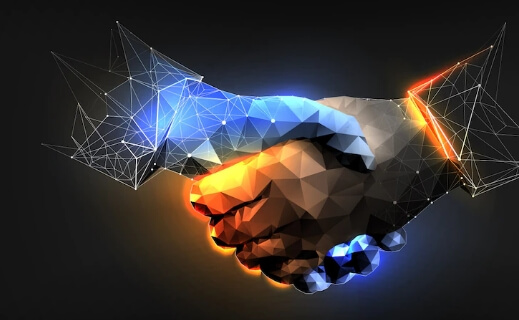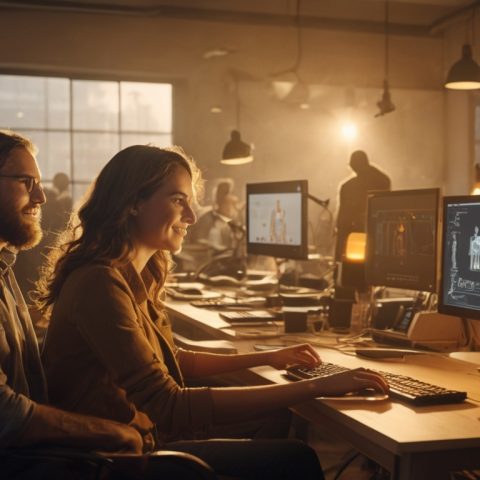Hey there, SmartOnes & fellow AI enthusiasts!
For today’s article, let’s keep things rolling from one of our previous posts a few weeks ago entitled “AI Photo Generators Are Shaking Up Traditional Photography” and continue on with AI photo generators, but this week, let’s talk about the super relevant and equally as important topic of text data annotation and how we can efficiently and properly use it. As mentioned in the post above, powerful tools like DeepArtEffects, MidJourney, and Runway ML are not just creating pretty pictures; they’re revolutionizing how we think about and interact with visual content. But how do we get to the point where AI can generate such incredible images? The secret sauce is in the meticulous process of text data annotation. Let’s explore further together…
Text Data Annotation – The Foundation Of AI Photo Generators
When you see those stunning AI-generated images, you might think, “Wow, how does it do that?” Well, behind those beautiful visuals is a lot of hard work in annotating text data. This process involves labelling and categorizing information so that AI algorithms, such as natural language processing (NLP) and machine learning (ML), can understand and learn from it.
What is Text Annotation?
Text annotation is like teaching a child to read and understand a new language. We add labels to text data—think marking parts of speech, identifying named entities, or flagging sentiments. This helps our AI models understand and generate language meaningfully, which in turn allows them to create those amazing images.
Why is Text Annotation Important?
Understanding text prompts is critical for AI photo generators. The better the AI understands these prompts, the more accurate and creative the generated images will be. By annotating text data, we train AI models to grasp nuances, context, and specific instructions, leading to more refined and relevant image outputs.
How to Get Started with Text Annotation
You might be wondering, “How do I even start annotating text data?” Here are some practical steps to guide you:
1. Define Your Goals
First things first, be clear about what you want to achieve. Are you training an AI to recognize specific objects, emotions, or scenes? Having a clear goal will help you decide what type of annotations are needed.
2. As Always, Choose the Right Tools
There are several tools out there to help with text annotation. Tools like LightTag, which offers collaborative annotation and data management features, and Prodigy, which provides a streamlined annotation workflow and active learning capabilities, offer user-friendly interfaces and powerful features to streamline the annotation process.
3. Create Your Annotation Guidelines
Consistency is vital in annotation. Develop clear guidelines outlining how and what to annotate. This ensures that everyone on your team follows the same standards, leading to a more uniform dataset.
4. Dive In, Start Annotating
Begin the annotation process, keeping your guidelines in mind. This might involve marking entities, labelling sentiments, or tagging parts of speech.
5. Review, Refine, & Then Refine Again…
Review the annotations regularly for accuracy and consistency. This involves checking if the annotations align with the guidelines and if they accurately represent the text data. Refine your guidelines and annotations as needed to improve the quality of your dataset. This iterative process helps the AI to better understand the nuances of human language and improve its image generation capabilities.
Real-World Example…
Ok, so now, here’s a short real-world example to see why this is so important. Imagine you’re developing an AI photo generator designed to create personalized travel postcards. You want the AI to generate images based on user descriptions, which are specific text prompts that describe the desired image, like “a serene beach at sunset” or “a bustling cityscape at night.” These descriptions serve as the input for the AI, guiding it to generate the desired image.
By annotating text data with descriptions of various scenes, emotions, and elements (like “serene,” “beach,” and “sunset”), you teach the AI to understand and generate images that match these descriptions accurately. The result? A tool that can turn simple text prompts into visually stunning and highly personalized postcards.
Let’s Go Even Deeper…
AI photo generators leverage annotated text to understand the context and details of prompts, which are specific text inputs that describe the desired image. These prompts can include details about the scene, emotions, or elements, like “a cozy, rain-soaked street in Paris” or “a futuristic cityscape under a starry sky.” The AI uses these prompts to produce images that are accurate and creatively rich, reflecting the details and emotions described in the prompts.
The power of AI photo generators is directly linked to the quality of text annotation. Annotating text data involves labelling and categorizing information so that AI algorithms can understand and learn from it. By meticulously tagging descriptions, emotions, and contextual details, we enable the AI to grasp the nuances of human language and translate it into visual content. This is why text annotation is not just a technical step but a creative one that shapes the output of AI-generated images, highlighting the importance of your contribution to the process.
AI photo generators empower professionals in the advertising industry, offering game-changing flexibility in styles and genres. From hyper-realistic portrayals to abstract interpretations, the possibilities are endless. This shift is particularly exciting for creatives, who can now generate high-quality images in minutes, refining their vision until it perfectly aligns with their goals. The democratization of high-end visual content through AI photo generators fosters a more vibrant and diverse creative community where fresh ideas and perspectives can flourish.
Imagine an advertising agency tasked with creating a visually compelling campaign. Traditionally, this would involve extensive brainstorming, photoshoots, and post-production work. With AI photo generators, the process becomes more efficient and dynamic. The agency can input text prompts like “a dynamic and energetic cityscape” or “a tranquil and minimalist interior” and instantly receive high-quality images that fit these descriptions. This rapid turnaround, made possible by robust text annotation, ensures that the AI understands and delivers precisely what is needed, sparking intrigue and eagerness to explore this new technology.
AI photo generators also stand to benefit the educational sector significantly. Teachers and students can use these tools to create custom visual aids, enhancing the learning experience with tailored, visually engaging content. History lessons can be brought to life with accurate reconstructions of historical scenes, while science classes can benefit from detailed and dynamic visualizations of complex concepts.
Quality and consistency in text annotation are crucial. Creating detailed annotation guidelines and conducting regular reviews ensures a reliable dataset from which the AI can learn, leading to better and more accurate image generation.
A Simple Case Study: Enhancing Creativity in Advertising
Consider an advertising agency looking to create a series of visually compelling ads. Traditionally, this would involve extensive brainstorming, photography sessions, and post-processing. With AI photo generators, the agency can input text prompts like “a dynamic and energetic cityscape” or “a tranquil and minimalist interior” and instantly receive high-quality images that fit these descriptions. Why not give it a try on
This not only speeds up the creative process but also allows for experimentation with different ideas and concepts without the need for costly photoshoots. The result is a more agile and creative workflow, where creatives can quickly iterate on their ideas, refining and adjusting the text prompts until they perfectly align with their vision. This flexibility and speed in the creative process are key benefits of using AI photo generators.
Some of the Challenges in Text Annotation…
Some of the challenges in text annotation are significant and multifaceted. While text annotation is powerful, it has its challenges. One common issue is the sheer volume of data that needs to be annotated. Manual annotation can be time-consuming and labour-intensive. Leveraging automation tools and crowdsourcing platforms can help mitigate these challenges, but they come with their own set of difficulties.
While efficient, automation tools may not always understand the nuanced context of certain data, leading to errors that need manual correction. Crowdsourcing, on the other hand, introduces variability in the quality of annotations, as contributors may have different levels of expertise and understanding of the guidelines.
Another challenge is ensuring the quality and consistency of annotations. This is where your annotation guidelines and regular reviews come into play. As we’ve discussed earlier, by maintaining high standards and continuously refining your process, you can build a reliable dataset from which your AI models can learn. However, developing comprehensive guidelines that are easy to follow yet detailed enough to cover all potential cases is a complex task.
Additionally, annotating subjective data, such as sentiments or emotions, poses a significant challenge. Different annotators might interpret the same text differently, leading to inconsistent annotations. Implementing a standardized approach to subjective annotation can be tricky and often requires iterative refinement and extensive training for annotators.
Balancing speed and accuracy is also a constant challenge. While it’s essential to annotate large datasets quickly to keep up with project timelines, rushing the process can compromise the quality of annotations. Striking the right balance between efficiency and accuracy often involves ongoing adjustments to processes and methodologies.
Lastly, dealing with evolving language and context in text annotation is another hurdle. Language is dynamic, and new terms, slang, or context-specific meanings can emerge, requiring continuous updates to annotation guidelines and retraining of annotators to ensure relevance and accuracy.
So What Does It All Mean Moving Forward?
The future of AI photo generators is auspicious. As text annotation techniques improve and AI models become more sophisticated, we can expect even more impressive advancements in this field. Imagine a world where AI can create photorealistic images from the most abstract text prompts, opening up new realms of creativity and expression.
Annotating text data is a foundational step in harnessing the full potential of AI photo generators. Understanding the importance of text annotation and following best practices, you can contribute to developing AI systems that revolutionize photography and beyond. However, if you need some help and are looking for a trusted partner to help you annotate your text data, feel free to reach out to us or be sure to check out our popular text analysis services.
So, next time you marvel at an AI-generated image, remember the meticulous work of text annotation that made it possible, and as we continue to innovate and refine these processes together, the possibilities are endless and limited only by our imagination.










